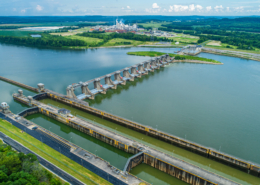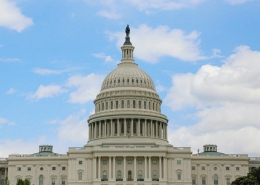The 2023 elections are fast approaching, and Eno is tracking around 70 transportation-related ballot measures across the United States. Compared to last year’s election, there may be fewer measures, but it is nonetheless important to cover transportation decision making. As we prepare for Tuesday, November 7, this will provide an overview of the playing field and some ballot measures to look out for.
Let’s do the numbers
Ballot measures are divided across four regions: North, South, Midwest, and West. Around 46 percent of ballot measures are in states that fall in the West, giving Western states the largest chunk of transportation ballot measures on the list. For the other regions, 22 percent of measures are in the South, 20 percent in the Midwest and about 10 percent of measures in the North.
Along with geography, ballot measures are categorized by primary and secondary mode. Categories of mode included roads, public transit, aviation, pedestrian, school transportation, and others. Roads as the primary mode account for 67 percent of ballot measures. However, many ballot measures include a bundle of transportation projects that include roads, highways, bridges, pedestrian infrastructure, public transit or some combination of these modes. About 13 percent of measures are focused on public transit, seven percent on school transportation, and only about 2 percent on aviation. Eleven percent of measures include pedestrian infrastructure within the bundle of transportation projects. Within a growing multi-modal approach to transportation, roads and associated infrastructure are the most common mode in the multi-modal bundle.
Bond measures are the common form of funding for transportation projects. Additionally, ballot measures include language to increase or establish taxes, including sales, property, or a special purpose tax.
Several ballot measures were voted on earlier this year, including measures from Alaska, California, Oklahoma, Vermont, Texas, and Kansas. In most of the elections except for Texas and California, voters approved measures that would increase or approve funding for various transportation projects like road maintenance and public transit. It is important to note that these outcomes do not guarantee approval of transportation projects and funding next week. But it does show support for transportation projects across the country.
Ballot measures from Ohio, save a couple of large measures, are not included in the numbers above. In Ohio alone, there are almost 150 transportation-related ballot measures, twice as many as the ballot measures being tracked across the country. The trend of roads as the dominant focus of transportation on the ballot is evident across Ohio as it is in the rest of the country.
Notable Measures on next week’s ballot
Ohio
One measure that is getting some attention is Issue No. 22 for Cincinnati, Ohio. The measure is to approve the sale of the Cincinnati Southern Railway to Norfolk Southern (NS) for $1.6 billion. The money from the sale would go towards infrastructure improvements including street repairs, parks and recreation, and municipal buildings.
The Cincinnati Southern Railway, built in 1879, is owned by the City of Cincinnati, under a 5-member board of trustees. The city leases the 337-mile railroad to Norfolk Southern, who operates trains on the railroad from Cincinnati to Chatanooga, TN. The Cincinnati Southern is the only municipally owned railroad in the United States.
Those in favor of the sale point to the increase in funding for infrastructure investment compared to leasing the railway to NS. Moreover, the once strategic asset is more of a financial asset that proponents want to maximize for the benefit of residents.
Those opposed to the sale are critical of selling a public asset to a private firm, which would remove the city’s ownership of the right-of-way and reduce the city’s ability to push for efforts like passenger rail. Additionally, opponents have voiced concerns over the use of money, citing investments in infrastructure that neglect communities of color. Some are opposed to Norfolk Southern acquiring the railway, in response to the NS derailment in East Palestine, OH.
Colorado
Several ballot measures in Colorado are focused on public transit. The Nederland EcoPass Public Improvement District expansion in Boulder County seeks to extend a property tax used to fund the program, which provides an EcoPass for unlimited trips on Regional Transportation District (RTD) services in the EcoPass District, serving the town of Nederland and surrounding region. Ballot Issue 2B for the City of Fountain would establish a 1 percent sales and use tax to improve roadways and transit. The measure would also expand the Pikes Peak Rural Transportation Authority to include the City of Fountain, expanding public transit options to city residents.
Additionally, Fort Collins Issue No. 1 would see a 0.5 percent sales tax increase towards public transit improvements for its TransFort service.
Texas
This year, several ballot measures in Texas are for school-related transportation, including new buses and transportation facilities. School districts in Denton and Harris counties are proposing over $3.5 billion in school-related measures, which include transportation improvements. In local elections, there are many bond measures for school districts, and this year is no exception. However, the inclusion of school transportation shows a trend towards not just the school itself but how students access school.
Several counties in Georgia, including Hall, DeKalb, and Floyd have Special Purpose Local Option Sales Taxes (SPLOST) on the ballot this year, which are 1 cent or 1 percent taxes used for capital improvement, road maintenance, and pedestrian infrastructure.
These are just a few of the transportation ballot measures that voters will decide on next Tuesday. Measures range from massive sales or infrastructure funding to smaller roadway repairs. Transportation measures on the ballot can have an impact on the people who vote for them, regardless of the size or region, making its coverage a worthy endeavor.
If there are transportation-related ballot measures that you think should be covered, send suggestions to shusain@enotrans.org.
Stay tuned for a follow-up piece on the results and impacts of next week’s elections!
The Eno Center for Transportation does not formally endorse or oppose any of the measures













